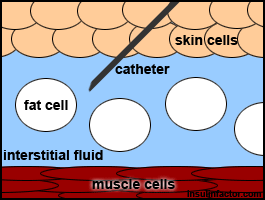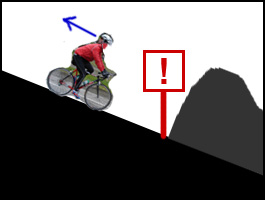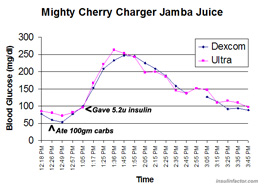|

No skiing today, let it snow.

Interstitial fluid.

Always looking behind can be dangerous.

Jamba Juice Test: Dexcom vs Ultra (click for larger graph).
|
4/16/06:
Altitude, Interstitial, and Jamba Juice
Unfortunately,
my skiing plans didn't work out thanks to a snowstorm that
shut down most of Lake Tahoe's resorts. Even though I don't
have any skiing stories to share, I have noticed some interesting
things with Dexcom over the past few days. Just before leaving
for the mountains, I inserted, initialized, and calibrated
a new sensor. Throughout the four hour drive to Tahoe I had
great readings. I went to bed a little high, about 200, and
gave a correction bolus.
Shortly
after falling asleep, I was woken up by Dexcom's "HIGH"
alert which meant I was over 200. It had only been 15 minutes
since I gave the correction bolus, so I ignored the alert
and went back to sleep. Dexcom continued to alert, waking
me up every 45 to 60 minutes, for the rest of the night. Finally,
I woke up at 6:45am to another "HIGH" alert and
Dexcom was also asking for a calibration. A finger stick with
the Ultra read 127, which is normal. A few minutes after calibrating
the new test, Dexcom alerted, once again, this time asking
to remove the sensor. Frustrated at my lack of sleep, the
inaccurate results, and the waste of a new sensor, I looked
at the nine hour trend graph to look for an explanation.
The graph
looked like a random array of dots ranging from 120 to 250.
I must have had a "noisy" site, but it didn't make
sense that I had great readings up until bedtime. I wonder
if the "noise" was caused by my body adjusting to
Lake Tahoe's 6,500 ft elevation? Changes in altitude strangely
affect my BG's and I haven't been able to figure out a pattern.
At altitude, sometimes I go high, while other times I'm extremely
sensitive to insulin. I initialized a new sensor and received
good readings for the rest of the weekend.
Over the
weekend, my grandma called to share that she really enjoyed
reading my blog about Dexcom. When I was first diagnosed with
diabetes, 16 years ago, Grandma attended the 3-day "diabetes
boot camp" with me and my family. She was surprised how
much diabetes technology had improved since my diagnosis.
Grandma also asked me for a definition of interstitial fluid.
I was a little surprised by her question, but even more surprised
at my lack of a good answer.
After
some thorough research, I found that interstitial fluid is
a water solvent containing amino acids, fatty acids, enzymes,
hormones, neurotransmitters, salts, cellular waste products,
and glucose. Interstitial fluid is found throughout the body,
bathes the cells of the body's tissues, delivers materials
to cells, and removes metabolic waste. Studies have shown
that the glucose in interstitial fluid can be used to estimate
the glucose in blood plasma. The Dexcom sensor measures interstitial
glucose every five minutes through a tiny platinum electrode
(about the size of a human hair) under the skin.
Even though
there is a strong relationship between interstitial and blood
glucose values, these values are not the same, which is why
you shouldn't dose insulin or eat carbs without doing a finger
stick. When I first put on Dexcom, the rep said I would probably
see a ten minute lag between sensor and finger stick BG readings.
I have occasionally noticed discrepancies between readings,
usually during or after intense exercise, when my BG values
are changing rapidly. These experiences have reinforced the
importance of not dosing insulin solely based on Dexcom readings.
Due to
the ten minute delay, dosing on sensor readings would be just
like riding my bike while looking behind, over my shoulder
(see picture). Always looking behind gives a lot of information
about the past, but gives no information about the present.
Without current information, I could run into unexpected obstacles
or dangers, especially when conditions are changing quickly.
Whether riding bikes or managing diabetes, I need to know
where I currently am, in order to make good decisions for
the future.
Without
consistent data, I couldn't really determine my time delay
between sensor and finger stick readings. So, I thought I
would put my Dexcom to another test… the Jamba Juice
Test. I went to a local Jamba Juice and ordered a regular
sized "Mighty Cherry Charger" smoothie which had
103gm of carbs. I recorded Dexcom and finger stick BG readings
every ten minutes over three hours. Before taking my first
sip I was a little low, so I gave insulin (5.2 units) after
my BG started to rise (about 15 minutes later). I expected
to see a 5 to 10 minute delay between readings.
Eighteen
or so finger sticks later (leaving painful, swollen fingertips),
the graphed comparison data (left) surprisingly revealed that
the Dexcom and finger stick readings were almost identical!
During this test, there really wasn't a time delay between
readings. Even more interesting and amazing, was that the
test was taken during my sixth day of wearing the same sensor
(I figured out how to extend the sensor life and Dexcom has
applied to the FDA for seven day sensor use). Very accurate
results on the sixth day of sensor use increased the level
of trust between me and Dexcom significantly.
I'm looking
forward to more comparison tests, especially with exercise,
but I need to wait and give my fingertips a bit of a break.
Regards,
Matt
I do
not work for nor am I compensated by Dexcom in any way. I'm
writing this story because I think continuous glucose technology
is interesting and exciting. Also, I am not a health care
professional and do not give medical advice. I will share
my experiences, but please check with your health care team
before making any changes to your diabetes or health management.
|



